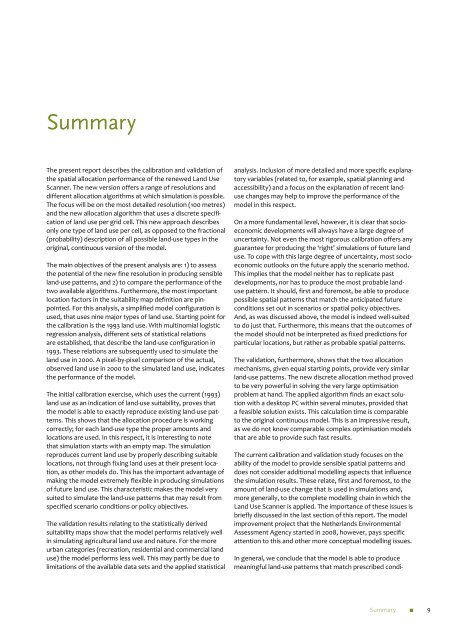PBL rapport 550026002 Calibration and validation of the land use ...
PBL rapport 550026002 Calibration and validation of the land use ...
PBL rapport 550026002 Calibration and validation of the land use ...
You also want an ePaper? Increase the reach of your titles
YUMPU automatically turns print PDFs into web optimized ePapers that Google loves.
Summary<br />
The present report describes <strong>the</strong> calibration <strong>and</strong> <strong>validation</strong> <strong>of</strong><br />
<strong>the</strong> spatial allocation performance <strong>of</strong> <strong>the</strong> renewed L<strong>and</strong> Use<br />
Scanner. The new version <strong>of</strong>fers a range <strong>of</strong> resolutions <strong>and</strong><br />
different allocation algorithms at which simulation is possible.<br />
The focus will be on <strong>the</strong> most detailed resolution (100 metres)<br />
<strong>and</strong> <strong>the</strong> new allocation algorithm that <strong>use</strong>s a discrete specification<br />
<strong>of</strong> l<strong>and</strong> <strong>use</strong> per grid cell. This new approach describes<br />
only one type <strong>of</strong> l<strong>and</strong> <strong>use</strong> per cell, as opposed to <strong>the</strong> fractional<br />
(probability) description <strong>of</strong> all possible l<strong>and</strong>-<strong>use</strong> types in <strong>the</strong><br />
original, continuous version <strong>of</strong> <strong>the</strong> model.<br />
The main objectives <strong>of</strong> <strong>the</strong> present analysis are: 1) to assess<br />
<strong>the</strong> potential <strong>of</strong> <strong>the</strong> new fine resolution in producing sensible<br />
l<strong>and</strong>-<strong>use</strong> patterns, <strong>and</strong> 2) to compare <strong>the</strong> performance <strong>of</strong> <strong>the</strong><br />
two available algorithms. Fur<strong>the</strong>rmore, <strong>the</strong> most important<br />
location factors in <strong>the</strong> suitability map definition are pinpointed.<br />
For this analysis, a simplified model configuration is<br />
<strong>use</strong>d, that <strong>use</strong>s nine major types <strong>of</strong> l<strong>and</strong> <strong>use</strong>. Starting point for<br />
<strong>the</strong> calibration is <strong>the</strong> 1993 l<strong>and</strong> <strong>use</strong>. With multinomial logistic<br />
regression analysis, different sets <strong>of</strong> statistical relations<br />
are established, that describe <strong>the</strong> l<strong>and</strong>-<strong>use</strong> configuration in<br />
1993. These relations are subsequently <strong>use</strong>d to simulate <strong>the</strong><br />
l<strong>and</strong> <strong>use</strong> in 2000. A pixel-by-pixel comparison <strong>of</strong> <strong>the</strong> actual,<br />
observed l<strong>and</strong> <strong>use</strong> in 2000 to <strong>the</strong> simulated l<strong>and</strong> <strong>use</strong>, indicates<br />
<strong>the</strong> performance <strong>of</strong> <strong>the</strong> model.<br />
The initial calibration exercise, which <strong>use</strong>s <strong>the</strong> current (1993)<br />
l<strong>and</strong> <strong>use</strong> as an indication <strong>of</strong> l<strong>and</strong>-<strong>use</strong> suitability, proves that<br />
<strong>the</strong> model is able to exactly reproduce existing l<strong>and</strong>-<strong>use</strong> patterns.<br />
This shows that <strong>the</strong> allocation procedure is working<br />
correctly; for each l<strong>and</strong>-<strong>use</strong> type <strong>the</strong> proper amounts <strong>and</strong><br />
locations are <strong>use</strong>d. In this respect, it is interesting to note<br />
that simulation starts with an empty map. The simulation<br />
reproduces current l<strong>and</strong> <strong>use</strong> by properly describing suitable<br />
locations, not through fixing l<strong>and</strong> <strong>use</strong>s at <strong>the</strong>ir present location,<br />
as o<strong>the</strong>r models do. This has <strong>the</strong> important advantage <strong>of</strong><br />
making <strong>the</strong> model extremely flexible in producing simulations<br />
<strong>of</strong> future l<strong>and</strong> <strong>use</strong>. This characteristic makes <strong>the</strong> model very<br />
suited to simulate <strong>the</strong> l<strong>and</strong>-<strong>use</strong> patterns that may result from<br />
specified scenario conditions or policy objectives.<br />
The <strong>validation</strong> results relating to <strong>the</strong> statistically derived<br />
suitability maps show that <strong>the</strong> model performs relatively well<br />
in simulating agricultural l<strong>and</strong> <strong>use</strong> <strong>and</strong> nature. For <strong>the</strong> more<br />
urban categories (recreation, residential <strong>and</strong> commercial l<strong>and</strong><br />
<strong>use</strong>) <strong>the</strong> model performs less well. This may partly be due to<br />
limitations <strong>of</strong> <strong>the</strong> available data sets <strong>and</strong> <strong>the</strong> applied statistical<br />
analysis. Inclusion <strong>of</strong> more detailed <strong>and</strong> more specific explanatory<br />
variables (related to, for example, spatial planning <strong>and</strong><br />
accessibility) <strong>and</strong> a focus on <strong>the</strong> explanation <strong>of</strong> recent l<strong>and</strong><strong>use</strong><br />
changes may help to improve <strong>the</strong> performance <strong>of</strong> <strong>the</strong><br />
model in this respect.<br />
On a more fundamental level, however, it is clear that socioeconomic<br />
developments will always have a large degree <strong>of</strong><br />
uncertainty. Not even <strong>the</strong> most rigorous calibration <strong>of</strong>fers any<br />
guarantee for producing <strong>the</strong> ‘right’ simulations <strong>of</strong> future l<strong>and</strong><br />
<strong>use</strong>. To cope with this large degree <strong>of</strong> uncertainty, most socioeconomic<br />
outlooks on <strong>the</strong> future apply <strong>the</strong> scenario method.<br />
This implies that <strong>the</strong> model nei<strong>the</strong>r has to replicate past<br />
developments, nor has to produce <strong>the</strong> most probable l<strong>and</strong><strong>use</strong><br />
pattern. It should, first <strong>and</strong> foremost, be able to produce<br />
possible spatial patterns that match <strong>the</strong> anticipated future<br />
conditions set out in scenarios or spatial policy objectives.<br />
And, as was discussed above, <strong>the</strong> model is indeed well-suited<br />
to do just that. Fur<strong>the</strong>rmore, this means that <strong>the</strong> outcomes <strong>of</strong><br />
<strong>the</strong> model should not be interpreted as fixed predictions for<br />
particular locations, but ra<strong>the</strong>r as probable spatial patterns.<br />
The <strong>validation</strong>, fur<strong>the</strong>rmore, shows that <strong>the</strong> two allocation<br />
mechanisms, given equal starting points, provide very similar<br />
l<strong>and</strong>-<strong>use</strong> patterns. The new discrete allocation method proved<br />
to be very powerful in solving <strong>the</strong> very large optimisation<br />
problem at h<strong>and</strong>. The applied algorithm finds an exact solution<br />
with a desktop PC within several minutes, provided that<br />
a feasible solution exists. This calculation time is comparable<br />
to <strong>the</strong> original continuous model. This is an impressive result,<br />
as we do not know comparable complex optimisation models<br />
that are able to provide such fast results.<br />
The current calibration <strong>and</strong> <strong>validation</strong> study foc<strong>use</strong>s on <strong>the</strong><br />
ability <strong>of</strong> <strong>the</strong> model to provide sensible spatial patterns <strong>and</strong><br />
does not consider additional modelling aspects that influence<br />
<strong>the</strong> simulation results. These relate, first <strong>and</strong> foremost, to <strong>the</strong><br />
amount <strong>of</strong> l<strong>and</strong>-<strong>use</strong> change that is <strong>use</strong>d in simulations <strong>and</strong>,<br />
more generally, to <strong>the</strong> complete modelling chain in which <strong>the</strong><br />
L<strong>and</strong> Use Scanner is applied. The importance <strong>of</strong> <strong>the</strong>se issues is<br />
briefly discussed in <strong>the</strong> last section <strong>of</strong> this report. The model<br />
improvement project that <strong>the</strong> Ne<strong>the</strong>rl<strong>and</strong>s Environmental<br />
Assessment Agency started in 2008, however, pays specific<br />
attention to this <strong>and</strong> o<strong>the</strong>r more conceptual modelling issues.<br />
In general, we conclude that <strong>the</strong> model is able to produce<br />
meaningful l<strong>and</strong>-<strong>use</strong> patterns that match prescribed condi-<br />
Summary 9
















